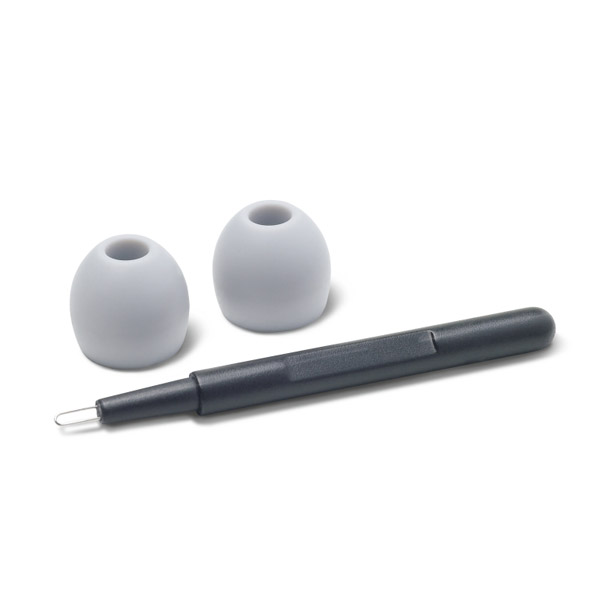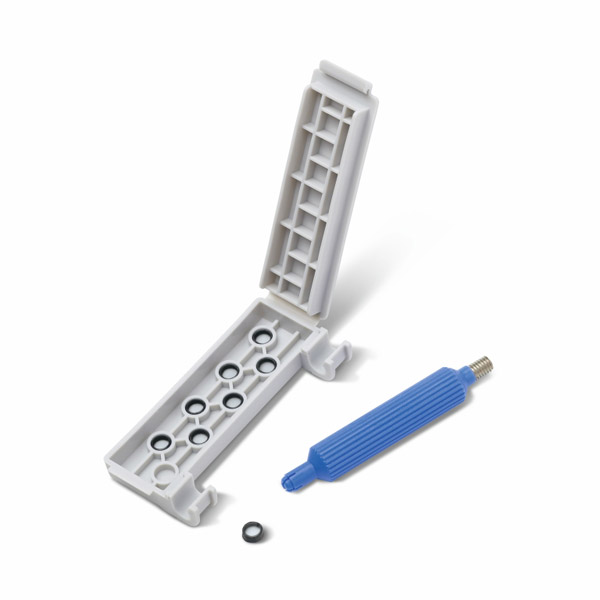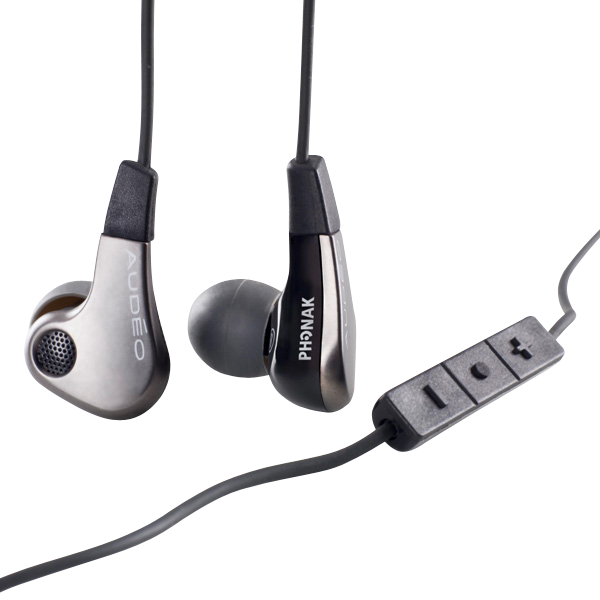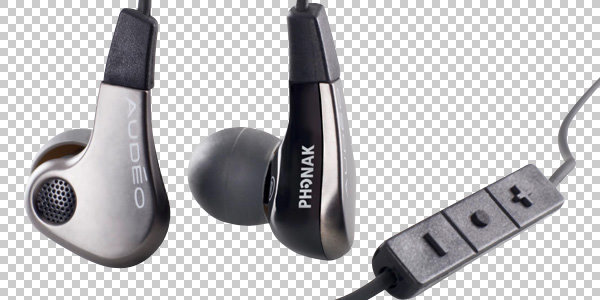Phonak Audéo PFE 232 Earphones
Product Details
Manufacturer: Phonak
Distributor: KS Distribution
Typical Selling price: £399.99
Description
High end earphones with microphone and control button system within the cable. Made for iPhone and iPad. Has an additional set of cables that can be fitted instead of the microphone-equipped ones, by dint of a plug-in system to the dual ‘˜balanced armature’ earpieces. They come with three sizes of rubber earplug fitments as well as a set of Comply„¢ soft memory-foam style plugs and an accessory kit that includes three sets of different filters to adjust the output to the taste of the user.
Specifications
– Impedance: 47 Ohms
– Drivers: Dual Balanced Armature in pods with perforated, vented rears
– Passband: 5Hz to 17kHz
– Sensitivity:
Grey Filter 109dBSPL/mW, @1Khz
Black Filter 107dBSPL/mW, @1Khz
Green Filter 104dBSPL/mW, @1Khz
– Weight: 16g, 0.5Oz
– Cable length: 120cm, 3.9ft
– C/W: spare leads without microphone for conversion to pure earphone, three different size pairs of soft rubber ear-fitting buds, 1 set of Comply„¢ foam ear-fitting buds, cleaning tool, filters and fitting tool and very strong fabric carrying case with two sections.
Editor Review : Phonak Audéo PFE 232 Earphones
I first learned about Audéo as a headphone brand at the Gadget Show Live a couple of years back. I was working for the Home Cinema Choice guys as compere on the live stage/stand they were running alongside Pioneer. We had a lot of seating and a shallow stage where I introduced all sorts of luminaries to talk about different tech subjects, from car audio to DJ to the use of digital music. There was a smaller stand opposite promoting a high end headphone brand and offering hearing tests and the chap there and I had a conversation or three during the week. At the end of the week, he presented me with a set of headphones. Well, Earphones, really, as in ‘˜Perfect Fit Earphones’ PFE.
They were the Phonak Audéo PFE 112 and I happily accepted these as I had been going through phone headsets at a rate of knots. I had been using the Blackberry supplied accessory and found them to be a simple trade descriptions act contravention! OK, I will say it. The headphones you get included with Research In Motion products are not fit for purpose. Unless that purpose is to be used for a month or so and then to simply disintegrate. And you can quote me. I went back to the Vodafone shop and was bellicose and demanding and did get them replaced. Twice. The third set were just getting a bit close to ruin (you could see the inner conductors where the cable sheathing had pulled out of the ear pieces, leaving them a hair’s thickness to put up with stress and strain) when I was given the natty Phonaks. The chap explained that the Swiss company were leaders globally in hearing healthcare products these last sixty years hearing aids – and so knew about sound and hearing and making small transducers and that Audéo was the HiFi brand of Phonak.
Not only were the PFE 111s much, much better sound quality than the stock RIM crap but they were fabulously rugged, made with non-gripping and solidly made cables and with a natty carrying case made from über-tough fabric. The little filters I found a bit fiddly but settled on one set and have used them happily since. In two years, I have no discernible wear and tear showing at all. Apart from the Comply„¢ foams reaching their end of life as they only last a while. You can get replacements but I found the other regular rubbery ones also supplied, perfectly comfy and offer great isolation.
But what I have before me now, is way, way past any issues of easy phone calls and use in and out of the car as a conversation goes from the office run, back indoors or I’m fishing and using both hands. For these little spuds are four hundred quid’s worth. The Phonak Audéo PFE 232.
Now, some may wonder about how a small set of speakers in little pods can cost £400 but all I can tell you is that teeny weeny transducers mean amazing micro-engineering. When you think about it, a microphone is just a transducer that works backwards. The sound hits the diaphragm which moves and the coil on its behind creates a small electrical impulse as it is being moved around within the gap of a magnet that’s a microphone ‘˜capsule’ or business end of the mic and a decent microphone can cost a serious slice, as can a top end set of hearing aids. The innards are described as dual armature, although it is not clear what that means. I gather it’s about one of the two tiny transducers inside being better at going up to the 17kHz top end and one better at wobbling all the way down to a quoted neo-subsonic 5Hz.
The filters are a conundrum. And I think it has all to do with the European MPO guidelines. (Music Power Output a crap term for ‘˜loudness’)
I had a filter set with the earlier, much less costly PFEs I used and settled on one. But these were different. Right from the off, I plugged the PFE 232s into my iPod Touch fourth gen and whizzed up Adele. I have the album 19 on the ‘˜Pod in two different resolutions and I could at last tell them apart. The sound is immediately apparent as tremendously detailed. I set about trying all the filters and read the instructions carefully.
These filters are all passive capsules. That is, there is no mad micro-miniature signal processing going on, there is simply a pad of material placed in the tiny plastic output-canal-liner of each earpiece that passively filters something out. What is left is what you hear. They are ‘˜tuned’ such that the Grey filter emphasises the midband (good for phone use), the Black filter is a ‘˜smiling face’ EQ filter as in it lets the tops and bass through best so emphasises the top and lower frequencies, while the Green filter is solely for allowing more bass through so as to offer ‘˜extra bass’.
Audéo of course are experts in the horn-style gain an ear or Pinna itself offers and thus knows we all hear slightly differently. I am cursed with absurd high frequency detail as my ears are as pointy as a pixie’s and I used to get called Spock at school until I learned to wear my hair over the ear tips. Also, my head is misshapen and one ear is a clear centimetre higher on one side than another. This gives me the locational cue information of a bloody Barn Owl, whose ear openings are arranged that way to catch mice. I can just tell where things are coming from. (In air at least, not underwater as the speed of sound is too quick for our brains I bet Dolphins can tell as they use ultrasound in their squeaks.) Anyway, the Phonak people talk about the transfer function of the outer ear canal and as an in-ear headphone is just that, you do not get any ‘˜ear gain’ and the filters are about recreating that.
However, I am troubled. I fail to believe that ANY piece of material can be so precisely arranged in the micro-filters so as to offer a perfectly unobstructed path to the sound it is ‘˜leaving alone’. In each case, each filter sounded as if there was a bit of padding over the bits it was ‘˜filtering’. In fact to this day, a sound attenuator placed in between the body and capsule of a microphone for use on stage in very high loudness environments, is called a ‘˜PAD’ as in a simple pad of muffley-wuffley cotton wool.
Also, I hate the laws that slow down motorcycles with maximum power-to-weight ratio limits and the Euro regs that say how loud we can play our music and despite the stuff about ear canal gain, I used the neat little filter tool (something I gather utterly transfixed that Jason bloke off the Gadget show with delight) to remove the bloody filters and try again.
And once again, I will stick my neck out.
I believe that unobstructed by the ‘˜healthy’ and ‘˜dust preventing’ filters, these earphones are truly at their most awesome. Don’t forget that all volume controls have three choices: 1) All the way on. 2) All the way off. 3) Somewhere in between. And with judicious use of all three, you aught to care for your hearing health.
Even more, I would even suggest that by adhering to the EU regs yet leaving it so easy to remove the filters, these are like that motorcycle that was supplied with a soft rubbery half-moon obstructing the air intake. It went up in horsepower, deeply in the naughty zone by cutting this out with a Stanley knife. So ignore the filters and you will be rewarded with one of the fastest, sweetest, richest and most plain lovely and musical experiences you can get from MP3.
Unfortunately, the sheer cleanliness and profound accuracy of these earphones has meant an all new level of gentle audiophillic disgust at the Empire Of The Apple’s effect on global fidelity issues and now, all I want is a player that can deal with FLAC and some FLAC files. (By the way bassheads, Google ‘Bass Mekanic’ for some wicked FLAC bass tunes for sale)
A lovely set of earphones and the microphone and button controllers are cool. Except they worked only intermittently with my BlackBerry Curve 8530. But no matter, for I use the 111s for the phone and the 232 for the better listening moments in my life, having fitted the non-mic lead-only cables to the capsules. Doing this was a doddle and proved a totally wicked level of über-posh build quality from a company obviously used to making stuff to be used every hour of your life. Made to last.
The hearing aid link up is the source of my sole complaint, which is that these, in order to ‘˜perfect fit’ need a bit more fussing with to get attached and installed to your head. After all, these guys are used to equipping a person with hearing aids, so a moment’s cranial installation time is irrelevant. But if you are in and out of a borrowed car and need to keep refitting, even one ear and leaving it dangling so you can plug in and answer the phone, it takes a minute or two to fit and use the little behind-the ear rubber tubey guide things that do look a bit hearing-aidish. I soon stopped bothering with the cable guides but it does take a moment or two to fit them, which I put up with due to their other qualities.
So there you have it, tremendous engineering and made to be louder than you are allowed if you do the naughty and remove the filters. As to quality, I have heard Stax’ Lambda Pro £12,000 electrostatic ‘˜ear speakers’ and Canton cans up to a couple of grand and other costly headphones. Thus I can tell you that even at £399, the Phonak Audéo PFE 232 offer a slice of decent value for money in that yes you can adjust and mess about and they have real durability and most of all, they sound bloody brilliant.
Lovely edges to strings, every shimmering tinkle of a bell tree hell you can count the tiny tubular bells. The cymbals no longer a pish but a susurrating sizzle of brassware. Drum beats hit leading edge first, which is rare and Adele, oh god so help me, Adele is right there, singing in your head and you can dream about kissing her as you can hear her tongueOMG too much detail again.
But the point is, these are a true audiophile experience and one you can take with you. Just avoid emotional music on the tube as folks will be uncomfortable and shuffle away from you if you sit there with tears rolling down your face.
An easily-scored Talk Audio Best Buy.
In a Nutshell
A very high quality set of earphones indeed. Offering such high quality sound that they represent good audiophillic Value For Money. Nice and adjustable for taste via the filters, or you can leave ‘˜em full bore for a truly potent experience. I loved these to bits and will be using them for the foreseeable. Utterly comfy to wear for as long as you need to, as these guys also make hearing aids that HAVE to be worn all day.
Overall 9.0
Sound Quality 9
Build Quality 10
Comfort (not P.Handling) 10
Isolation/Noise Cancellation 10
Value For Money 8


